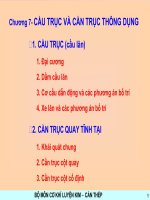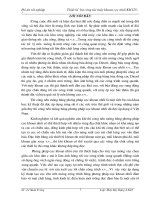Tài liệu Máy khoan cọc nhồi docx
Bạn đang xem bản rút gọn của tài liệu. Xem và tải ngay bản đầy đủ của tài liệu tại đây (4.74 MB, 41 trang )
Piles and Pile Driving
Jackson Tukuafu
Brandon Smith
•
//www.youtube.com/watch?
v=aNfDco8eXA8
•
/>v=o_kqh0aGEwo
Safety First
Pile Driving Terminology
Anchor Pile: pile that is connected to a structure
Butt of pile: the fat end of the pile
Cushion: spreads out impact of the hammer
Cutoff: height you cut your pile after its been driven
Downdrag: condition that adds load to the installed pile
Driving cap/ helmet: protects top of pile while
being driven
Embedment: how much is in the ground
Overdriving: too much driving damages your piles
Penetration: how far it goes in each time you hit it
Pile bent: more than one pile driven in a cluster
Pile-driving shoe: Metal shoe on bottom end to
make it go in better
Soldier pile: holds up an excavation
Tension pile: holds structure down from
being pulled out
Pile Hammers
Types of Hammers
•
Drop Hammers
• Single-acting steam or
compressed air
• Double-acting steam or
compressed air
•
Differential-acting steam
or compressed air
•
Diesel
• Hydraulic-impact and
drivers
•
Vibratory drivers
Hammer selection
considerations:
1. Number of piles
2. Character of the soil
3. Location of the project
4. Topography of site
5. Equipment available
6. Pile driving on land or
water
Pile Hammers
•
Drop Hammers
–
Only used in remote
areas with less piles
–
Time of completion is
not important
– Productivity
•
4-8 blows/min
–
Not suitable for
concrete piles
Pile Hammers
•
Double-Acting
Hammers
–
“ram” is driven by
compressed air to
steam both when
rising and when
falling
– 95-300
blows/min.
– Lighter ram and
high
Pile Hammers***
•
Single-Acting
Hammers
–
40-60 blows/min
– Sizes vary 7000-
1,800,000 ft-
lb/blow
–
“Ram” is lifted by
steam or
compressed air
and then dropped
Pile Hammers***
•
Differential-Acting
–
Uses the
advantages of a
single- and
double-acting
hammers
Pile Hammers
•
Diesel Hammers
–
Open end
•
40-55 blows/min.
–
Close end
• 75-85 blows/min.
–
Used in cohesive
or very dense soils
Pile Hammers***
•
Hydraulic Impact
Hammers
–
Operates on
differential pressure
of hydraulic fluid
– Uses a power unit
– Two types
•
Hydraulic drop
hammer
•
Double-Acting
hammer
Pile Hammer
•
Hydraulic Drivers
–
Press-in hydraulic
pile driver
–
Used for thrusting
and extracting
steel H piles and
steel sheet piles
–
Compact, minimal
noise, and little
vibration
Pile Hammers
•
Vibratory Pile
Driver
–
Used when piles
are driven into
water-saturated
non-cohesive soils
– Powered either
electrically or
hydraulically
Pile driving by Jacking
•
Used extensively
in underpinning
situations
Jetting Piles
•
Use of water to
assist in driving
piles into sand or
fine gravel
•
Reduces the
resistance due to
skin friction
Spudding and Preaugering
•
Solution to
preexisting
foundations,
previous
construction, hard
overlying soil
strata
Timber Piles
•
Typically 8" tip and 12" butt diameters
•
Common lengths 15' to 50'
•
Typically made from pressure treated
southern pine or Douglas fir woods
•
use includes temporary structures, docking
and fender systems, detour bridges and
Bailey bridges
G
Timber Piles, cont’d
Pile Driving Record
•
Average pile driving time: 17:22
•
Weight of Pile: 1087 lbs.
•
Weight of Ram: 900 lbs.
•
Rated Energy: 1800 ft*lbs.
•
Pile Dimensions: 25’ long, 10” diameter
•
Stroke length: 2.0’
•
Description of Driving Rig: Pile Master 24-900
•
Average # blows for last 12”: 220
Cost Data
Model 24-900 Model 24-2000 Model 24-2500 Model 36-3000
Ram Weight 900 2000 2500 3000
Hammer Weight 2300 4100 4600 6100
Variable Stroke
Minimum 0.5 0.5 0.5
Maximum 2 2 2 1
Energy Rating (Ft*lbs) 3
minimum 450 1000 1250 3000
maximum 1800 4000 5000 9000
blows per minute 15-72 15-72 15-72 15-55
Recommended PSI 125 CFM, 125 psi 185 CFM, 125 psi 185 CFM, 125 psi 250 CFM, 125 psi
Length of hammer: 9 9 10 10
Resistance of Piles to Penetration
Costs
Contract Amount: Cost Plus $6,250,
not to exceed $31,250
Reimbursement for Piling
Bobcat/Auger attachment
Air Compressor
Air Hammer
Labor
Crane Time/Delivery
Concrete
• Precast or cast in place
• Square, cylindrical, octagonal
shapes
• Prone to damage due to
flexural stress
• Drive with heavy ram, large
stroke,
low impact velocity
• Excavate Soil plug to existing
soil elevation
Concrete Piles:
Precast-Prestressed Concrete Piles
•
Displacement piles , the most common in Florida
•
Typically used where limestone or dense stratum is <125'
•
Used in corrosive environments
•
Used as friction piles, end bearing piles, and combination of both
•
Voided piles are made to reduce pile weight
•
Voided piles with solid ends provide some protection during driving
•
Driven as a group can densify soils in the immediate area
•
Large, heavy, hard to cut/splice
•
High transportation costs









